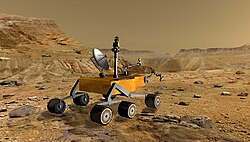PIA16453-MarsCuriosityRover-RocknestPanorama-20121126
http://photojournal.jpl.nasa.gov/catalog/PIA16453
This panorama is a mosaic of images taken by the Mast Camera (Mastcam) on the NASA Mars rover Curiosity while the rover was working at a site called "Rocknest" in October and November 2012.
The center of the scene, looking eastward from Rocknest, includes the Point Lake area. After the component images for this scene were taken, Curiosity drove 83 feet (25.3 meters) on Nov. 18 from Rocknest to Point Lake. From Point Lake, the Mastcam is taking images for another detailed panoramic view of the area further east to help researchers identify candidate targets for the rover's first drilling into a rock.
The image has been white-balanced to show what the rocks and soils in it would look like if they were on Earth. Figure 1 is a raw-color version, showing what the scene looks like on Mars to the camera.
JPL, a division of the California Institute of Technology, Pasadena, manages the Mars Science Laboratory Project for NASA's Science Mission Directorate, Washington. JPL designed and built the rover.Relevante Bilder
Relevante Artikel
Mars Science LaboratoryMars Science Laboratory ist eine NASA-Mission im Rahmen des Flagship-Programms, die den Mars hinsichtlich seiner aktuellen und vergangenen Eignung als Biosphäre erforscht. Hierzu wurde auf der Oberfläche ein weitgehend autonomer Rover mit dem Namen Curiosity abgesetzt, der mit zehn Instrumenten zur Untersuchung von Gestein, Atmosphäre und Strahlung ausgerüstet ist. Zu deren Analyse kommen neben einer großen Zahl unterschiedlicher Spektrografen auch Kameras und meteorologische Instrumente zum Einsatz, welche die Messdaten für die Auswertung zur Erde schicken. Mit einer Masse von 900 kg und der Größe eines kompakten Kleinwagens war Curiosity bis zur Landung von Perseverance im Februar 2021 das schwerste von Menschen geschaffene Objekt auf der Marsoberfläche und löste die Viking-Tochtersonden mit je knapp 600 kg ab. .. weiterlesen










































